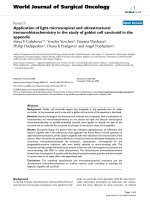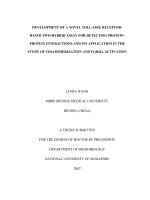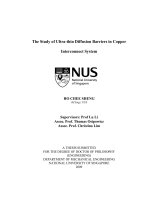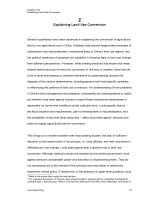The study of GRIM 19 function in mitochondria
Bạn đang xem bản rút gọn của tài liệu. Xem và tải ngay bản đầy đủ của tài liệu tại đây (3.49 MB, 141 trang )
THE STUDY OF GRIM-19 FUNCTION IN
MITOCHONDRIA
Lu Hao
A THESIS SUBMITTED FOR
THE DEGREE OF DOCTOR OF PHILOSOPHY
THE INSTITUTE OF MOLECULAR AND CELL BIOLOGY
NATIONAL UNIVERSITY OF SINGAPORE
2007
i
ACKNOWLEDGEMENTS
In the last 5 years, I have learnt and grown, with great appreciation to many
peoples.
First and foremost, I would like to express my deep and sincere gratitude to my
supervisor, Dr. Xinmin Cao, for giving me the opportunity to pursue my Ph.D. research
work in her laboratory. Her understanding, encouragement and personal guidance
provided a very good basis for my thesis.
I am really grateful to all my labmates and friends in IMCB, past and present, for
the stimulating and extensive discussions, sharing of reagents, technical assistances and
friendship.
I owe my graduate supervisory committee, Prof. Hong Wanjin and Dr. Cai
Mingjie my sincere gratitude, for their constructive suggestions and critical comments.
I also wish to express my thanks to Prof. Christopher J Leaver for sharing the
Blue-Native PAGE protocol, which is a really useful and important method for me to
study the GRIM-19 functions in this thesis.
I am deeply grateful to Dr. Lim Cheh Peng for her critical comments on my
thesis writing.
Finally, I am forever indebted to my parents and my wife for their understanding,
endless patience and encouragement when it was most required.
ii
LIST OF PUBLICATIONS
Hao Lu, and Xinmin Cao. GRIM-19 is essential for maintenance of mitochondrial
membrane potential. Mol, Biol, Cell. (Submitted to MBC after revision).
Huang G, Lu H, Hao A, Ng DC, Ponniah S, Guo K, Lufei C, Zeng Q, Cao X. GRIM-19,
a cell death regulatory protein, is essential for assembly and function of mitochondrial
complex I. Mol. Cell. Biol. 2004. 24, 8447-8456.
Huang G., Chen Y., Lu H., and Cao X. (2007). Coupling mitochondrial respiratory chain
to cell death: an essential role of mitochondrial complex I in the interferon-beta and
retinoic acid-induced cancer cell death. Cell Death Differ. 2007. 14, 327-337.
Chen Y, Yuen W., Fu J., Huang G., Melendez A. J., Ibrahim F.B., Lu H., and Cao X.
Mitochondrial respiratory chain controls intracellular calcium signaling and NFAT
activity essential for heart formation in Xenopus. Mol. Cell. Biol. 2007. 27, 6420-6432.
iii
TABLE OF CONTENTS
Acknowledgements……………………………………………………………………….II
List of publications …………………………………………………………………… III
Table of contents…………………………………………………………………………IV
Abbreviations…………………………………………………………………………….IX
List of figures………………………………………………………………………… XIV
List of tables…………………………………………………………………………….XV
Summary……………………………………………………………………………….XVI
Chapter 1 Introduction…………………………………………………………… 1
1.1 Mitochondrion and mitochondrial respiratory chain………………………… 2
1.1.1 Mitochondrion………………………………………………………… 2
1.1.2 Mitochondrial structure………………………………………………….3
1.1.3 Mitochondrial oxidative phosphorylation……………………………….5
1.1.4 Mitochondrial respiratory chain and membrane potential………………6
1.1.5 Mitochondrial dysfunction and disease……………………………… 13
1.2 Mitochondrial Complex I………………………………………………… 18
1.2.1 The subunits of mitochondrial Complex I………………………… 18
1.2.2 The structure of mitochondrial Complex I…………………………… 20
1.2.3 the import of Complex I subunits…………………………………… 21
1.2.4 The assembly of mitochondrial ComplexI…………………………… 25
1.3 GRIM-19…………………………………………………………………… 30
iv
1.4 Objective and significance of this study…………………………………….31
Chapter 2 Material and Methods……………………………………………… 34
2.1 Chemicals and reagents …………………………………………………… 35
2.2 Cells culture………………………………………………………………….35
2.3 Generation and culture of ρ0 cells………………………………………… 35
2.4 Plasmid constructions……………………………………………………… 36
2.5 Preparation of DH5α Escherichia coli competent cells…………………… 38
2.6 DNA transformation…………………………………………………………38
2.7 DNA transfection byLipofectamine 2000……………………………………39
2.8 QuikChange™ Site-Directed Mutagenesis………………………………… 39
2.9 Western blot analysis……………………………………………………… 40
2.10 Immunoprecipitation……………………………………………………… 40
2.11 Immunofluorescence ……………………………………………………….41
2.12 Generation of a mouse antibody against human GRIM-19 …………41
2.13 In vitro transcription and translation……………………………………… 42
2.14 Measurement of ∆ψm………………………………………………………42
2.15 Mitochondrial isolation…………………………………………………… 42
2.16 Cytochrome c release assay……………………………………………… 43
2.17 Blue-Native PAGE and in gel activity assay……………………………….43
2.18 Complex I spectrophotometric enzyme assay………………………………44
2.19 Apoptosis assay (sub-G1 assay)…………………………………………….44
2.20 Isolation and culture of blastocysts in vitro………………………….45
v
2.21 Preparation of RNA……………………………………………………… 45
Chapter 3 GRIM-19 is a subunit of mitochondrial complex I………… 47
3.1 GRIM-19 interacts with various subunits of mitochondrial complex
I……………………………………………………………………….48
3.2 GRIM-19 is a component of mitochondrial complex I……………….52
3.3 GRIM-19 is essential for mitochondrial complex I assembly and
enzymatic activity…………………………………………………….52
Chapter 4 GRIM-19 functional domains
…………………………………… 56
4.1 Residues 20-30 and 40-60 Are Required for Mitochondrial Localization of
GRIM-19…………………………………………………………………….57
4.2 Residues 134-144 Affects GRIM-19 Insertion to Complex I………………62
4.3 Aa 70-80 and 90-100 Are Required for Maintenance of ΔΨm…………….65
Chapter 5 Dominant negative mutant of GRIM-19 impairs
mitochondrial membrane potential
…………………………….71
5.1 Generation of a Dominant Negative GRIM-19 Mutant Which Disrupts
ΔΨm…………………………………………………………………… ….72
5.2 DN-GRIM-19 Compromises Complex I Activity without Affecting Its
Assembly………………………………………………………………… 72
5.3 Loss of ΔΨm Caused by DN-GRIM-19 does not Induce Cytochrome c
vi
Release and Apoptosis………………………………………………… … 79
5.4 Loss of ΔΨm Caused by DN-GRIM-19 Sensitizes Cells to Undergo
Apoptosis……………………………………………………………………82
Chapter 6 Discussion 88
6.1 GRIM-19 Is Localized in Mitochondria…………………………………… 89
6.2 GRIM-19 Is a Critical Subunit of RC Complex I……………………… 90
6.2.1 GRIM-19 is essential for mitochondrial complex I assembly and
activity……………………………………………………………… 90
6.2.2 GRIM-19 is a functional subunit in mitochondrial complex I… 90.
6.3 The Position of GRIM-19 in Mitochondrial Complex I………………………92
6.4 The Important Function of Accessory Subunits in Mitochondrial
Complex I……………………………………………………………… 93
6.5 DN-GRIM-19 as a Novel Tool for Functional Study of ΔΨm in
Apoptosis………………………………………………………………….…94
6.6 RC/Complex I Regulates Cell Death via Different Mechanisms…………….95
6.7 GRIM-19 could be a potential therapy candidate in diseases…………………96
6.7.1 GRIM-19 and embryonic development disorders……………………… 96
vii
6.7.2 GRIM-19 and cancer…………………………………………………….97
6.7.3 GRIM-19 and bacterium/virus infection…………………………… …98
References 100
viii
ABBREVIATIONS
∆ψm mitochondrial membrane potential
ACP acyl-carrier protein
ATP adenosine triphosphate
Β-gal β-galactosidase
BSA bovine serum albumin
CIA complex I intermediate-associated
Cyt cytochrome
DMEM Dulbecco’s modified Eagle’s medium
DMSO dimethyl sulfoxide
DMF dimethylformamide
DNA deoxyribonucleic acid
DTT dithiothreitol
ECL enhanced chemiluminescence
EDTA ethylenediamine tetra-acetic acid
ER endoplasmic reticulum
ETC electron transport chain
FAD flavin adenine nucleotide; oxidized state
FADH
2 flavin adenine nucleotide; reduced state
FBS fetal bovine serum
FMN Flavin MonoNucleotide
FP flavoprotein
ix
GRIM-19 genes associated with retinoid IFN-induced
Mortality-19
GST glutathione S-transferase
HA hemagglutinin
HEPES N-(2-hydroxyethyl) piperazine-N’-(2-
ethanesulfonic acid)
HGNC HUGO Gene Nomenclature Committee
HP hydrophobic protein
Hsp60 heat shock protein 60 kDa
IFN-β interferon- β
IP iron-sulfur protein
IPTG isopropylthio-β-D-galactoside
MIB mitochondrial isolation buffer
MIM mitochondrial inner membrane
MOM mitochondrial outer membreane
MRC mitochondrial respiratory chain
mtRNA mitochondrial DNA
NaCl sodium chloride
NAD nicotinamide adenine dinucleotide; oxidized state
NADH nicotinamide adenine dinucleotide; reduced state
NDUFA NADH dehydrogenase (ubiquinone) 1 alpha
subcomplex
NDUFS NADH dehydrogenase (ubiquinone) Fe-S protein
x
NDUFV NADH dehydrogenase (ubiquinone) flavoprotein
kDa kilodaltons
KCl potassium chloride
LB Luria Bertani
LDAO laury-dimethyfamine oxide
ORF open reading frame
OXPHOS oxidative phosphorylation
RC respiratory chain
PAGE polyacrylamide gel electrophoresis
PBS phosphate-buffered saline
PCR polymerase chain reaction
PVDF polyvinylidene difluoride
Q ubiquinone
QH2 reduced ubiquinol
QH ubisemiquinone radicals
RA retinoic acid
RIPA radioimmune precipitation assay
RNA ribonucleic acid
rRNA ribosomal ribonucleic acid
ROS reactive oxygen species
SDS sodium dodecyl sulphate
siRNA small interfering RNA
STAT signal transducers and activators of transcription
xi
TCL total cell lysate
TIM translocator inner membrane
TNF-α tumor necrosis factor-beta
TOM translocator outer membrane
tRNA transfer ribonucleic acid
Tyr tyrosine
VDAC voltage-dependent anion channel
xii
LIST OF FIGURES
Figure 1.1. The electron microscopy picture of a mitochondrion………………… 2
Figure 1.2. The structure of a mitochondrion……………………………………… 3
Figure 1.3. A schematic picture of the morphology and function of RC……………7
Figure 1.4. The structure of bovine mitochondrial complex I…………………… 20
Figure 1.5. The translocation complexes of mitochondria………………………….22
Figure 1.6. The human mitochondrial complex I assembly models……………….29
Figure 3.1. Mouse GRIM-19 associates with mitochondrial complex I subunits….49
Figure 3.2. GRIM-19 is associated with various mitochondrial complex I
subunits………………………………………………………….50
Figure 3.3. Detection of GRIM-19 in complex I by BN-PAGE……………………53
Figure 3.4. GRIM-19 is essential for mitochondrial complex I assembly
and enzymatic activity ………………………………………….55
Figure 4.1. The Schematic diagram of GRIM-19 internal deletion and C-
terminal deletion mutants…………………………………………… 58
Figure 4.2. GRIM-19 aa 20-30 and 40-60 are mitochondrial localization signals 59
Figure 4.3. Aa 134-144 of GRIM-19 affects its assembly ability to complex I… 63
Figure 4.4. Point mutants (G139R, Y143D and Y143A) affect the assembly
ability of GRIM-19 to complex I…………………………………… 64
Figure 4.5. Aa 70-80 and 90-100 of GRIM-19 are required for maintenance of
xiii
ΔΨm……………………………………………………………………66
Figure 4.6. Quantitatively measurement of ΔΨm in GIRM-19 mutants transfected
Cells……………………………………………………………………68
Figure 5.1. DN-GRIM-19 strongly reduces ΔΨm………………………………….73
Figure 5.2. DN-GRIM-19 reduces ΔΨm without affecting mitochondria integrity.74
Figure 5.3. DN-GRIM-19 decreases mitochondrial complex I electron transfer
activity…………………………………………………………………75
Figure 5.4. The NADH oxidation rate is decreased in DN-GRIM-19 transfected
cells…………………………………………………………………….77
Figure 5.5. DN-GRIM-19 does not reduce ΔΨm in ρ0 cells……………………….80
Figure 5.6. DN-GRIM-19 does not affect the expression of various mitochondrial
subunits……………………………………………………………… 81
Figure 5.7. Loss of ΔΨm caused by DN-GRIM-19 does not induce cytochrome c
release and apoptosis………………………………………………….84
Figure 5.8. DN-GRIM-19 sensitizes cells to cytochrome c release……………….85
Figure 5.9. DN-GRIM-19 sensitizes cells to apoptosis……………………………86
Figure 6.1. Functional domains of GRIM-19…………………………………….91
xiv
LIST OF TABLES
Table 1.1 The nuclear encoded mitochondrial complex I subunits from bovine heart
mitochondria………………………………………………………………19
Table 1.2 The presequences or modification of mitochondrial complex I subunits….24
Table 2 The NADH oxidation rates in vector , GRIM-19, DN-GRIM-19 and
GRIM-19 1-60 transfected cells……………………………………………78
xv
SUMMARY
Mitochondria play essential roles in cellular energy production via mitochondrial
respiratory chain (RC), which contains five complexes. NADH:ubiquinone
oxidoreductase (complex I) is the largest complex that catalyzes the first step of electron
transport of RC. Due to the central role of RC in cellular metabolism, any dysfunction of
RC will cause severe disease with multi-system disorders. Among all of mitochondrial
RC disorders, mitochondrial complex I deficiency is the most common case. Moreover,
mitochondrial complex I is also the major source of reactive oxygen species (ROS) in
cells, which now is believed to play very important roles in aging and aging-related
diseases such as neurodegenerative diseases, diabetes and cancer. Therefore, the research
on mitochondrial complex I has now become an exciting and fast developing field.
GRIM-19, which was initially identified as a nuclear protein, has important roles in
interferon-β (IFN) and retinoic acid (RA) induced apoptosis and was also reported to co-
purify with mitochondrial complex I. However, the relationship between GRIM-19 and
complex I was not clear. This study clearly demonstrates that GRIM-19 is a subunit of
mitochondrial complex I by showing: (1) GRIM-19 interacted with various mitochondrial
complex I subunits and was physically present in mitochondrial complex I. (2) In GRIM-
19 knockout mice, mitochondrial complex I holoenzyme could not be fully assembled
and complex I activity was totally abolished, indicating that GRIM-19 is essential for
complex I assembly and enzymatic activity. In addition, several important functional
domains in GRIM-19 were identified. The mitochondrial localization sequences were
defined at the N-terminus, the electron transfer activity domain was found in the middle
and the last 10 amino acid at C-terminus enhanced the assembly ability of GRIM-19 to
xvi
complex I. Based on the domain-mapping information, a dominant-negative GRIM-19,
which can specifically decrease mitochondrial membrane potential, was generated.
In summary, I have demonstrated that GRIM-19 was a crucial subunit in
mitochondrial complex I.
xvii
xviii
Chapter 1 Introduction
1
1.1 Mitochondrion and mitochondrial respiratory chain
The cell is the basic structural and functional unit of all living organisms
(Bruce, 2002). All of the cell’s behavior, such as movement, secretion, division
and activation of signaling pathway, required the supply of energy. A small
organelle inside the cells called mitochondrion fulfills this important role.
1.1.1 Mitochondrion
Figure 1.1. An electron microscopy picture of a mitochondrion
Mitochondria in animal cells were first identified as a subcellular structure by
light microscopy in the 1840s (Immo, 2002). Plant mitochondria were observed
in 1904. Mitochondria can be distinguished from other cellular organelles by their
ability to be stained with the redox dye Janus Green (Helen, 1938). This dye can
be oxidized into a colored form by cytochrome c oxidase in mitochondria.
Mitochondria can be found in most eukaryotic cells (
Henze et al., 2003).
They serve as the power supply center in cells by generating the majority of ATP
for all kinds of cellular activities. The shapes of mitochondria are usually rod-like
or thread-like. The number of mitochondrion depends on the cell type ranging
2
from 1 to thousands of mitochondria per cell (Alberts et al., 1994 and Voet et
al.,
.2006) The diameters of mitochondria is like a bacterium from 1 to 10
micrometers (μm). Although the nucleus contains most of the DNA in cells, the
mitochondrion has its own genome (Wolstenholme, 1992).
1.1.2 Mitochondrion structure
Figure 1.2. The structure of a mitochondrion
Like the nucleus, the mitochondrion contains double membranes. The outer
membrane of the mitochondrion is quite smooth. However the inner membrane is
convoluted into cristae. These two membranes and cristae separate a
mitochondrion into five distinct compartments: outer membrane, inter-membrane
space, inner membrane, cristae space and mitochondrial matrix.
(1) Mitochondrial outer membrane
3
The mitochondrial outer membrane encloses the whole organelle. The
protein - phospholipid ratio of the mitochondrial outer membrane is about 1:1
by mass, similar to the cell plasma membrane. It contains only about 5% of
the total mitochondrial proteins. The major protein is porin which makes the
mitochondrial outer membrane permeable to molecules of about 10 kDa or
less (the size of the smallest proteins). Ions, nutrient molecules, ATP, ADP,
etc. can also pass through the outer membrane. Several enzymes are located in
the outer membrane such as monoamine oxidase and NADH/cytochrome b5
oxido-reductase.
(2) Mitochondrial intermembrane space
The mitochondrial intermembrane space is the space between the outer
membrane and the inner membrane. It contains about 5% of mitochondrial
proteins. Some portion of cytochrome c (Cyt c), an extrinsic protein of the
respiratory electron transport chain involved in transferring electrons from
Complex III to Complex IV, is located here. Most of the dehydrogenases of
the inner mitochondrial membrane have access to the matrix side only.
However, some, such as glycerol 3-phosphate dehydrogenase, which
generates reducing equivalents from cytosolic NADH and donates them to the
electron transport chain, have access to the intermembrane space.
(3) Mitochondrial inner membrane.
The structure of the mitochondrial inner membrane is highly complex
and rich of proteins (the ratio of proteins to lipids is about 3:1 by weight). It
contains about 20% of the total mitochondrial proteins. The mitochondrial
4
inner membrane also contains an special lipid, cardiolipin (also called
bisphosphatidylglycerol), which accounts for about 20% of the total lipid
content of the inner membrane (McMillin et al., 2002). The inner membrane
is freely permeable only to oxygen, carbon dioxide, and water. There are three
major types of enzyme complexes in the mitochondrial inner membrane
including all of the complexes of the electron transport system, the ATP
synthetase complex, and transport proteins (Alberts et al., 1994).
(4) Mitochondrial cristae space
Mitochondrial cristae are the internal compartments which are formed by
the convoluted inner membrane. Many types of cytochromes are localized in
the mitochondrial critstae space.
(5) Matrix
The majority of mitochondrial proteins are located in the mitochondrial
matrix. The matrix contains the enzymes responsible for the citric acid cycle
reactions and fatty acid oxidation (Alberts et al., 1994). In addition, the
matrix also contains the ribosomes and other enzyme systems responsible for
the synthesis of mitochondrial DNA (mtDNA), RNA and proteins. Because of
the folds of the cristae, no part of the matrix is far from the inner membrane.
Dissolved oxygen, water, carbon dioxide and the recyclable intermediates can
diffuse into the matrix rapidly.
1.1.3 Mitochondrial oxidative phosphorylation
5
Why is the mitochondrion the “powerhouse” of the cell? This is because of
the special capability of mitochondria to carry out oxidative phosphorylation. So
far most of usable energy derived from fuel molecules such as carbonhydrate or
fats comes from mitochondrial oxidative phosphorylation.
Oxidative phosphorylation is an efficient metabolic pathway that utilizes
the energy released from the oxidation of fuel molecules to generate adenosine
triphosphate (ATP), the major energy supplier in cells. During this process,
electrons are transferred from electron donors such as NADH and FADH
2
to the
electron acceptors such as oxygen via redox reactions. The energy released from
these redox reactions is efficiently used to generate ATP. Compared to glycolysis,
oxidative phosphorylation is a much more efficient way to utilize the energy from
fuel molecules. For example, one molecule of glucose can only generate 4
molecules of ATP in glycolysis pathway, however, one molecule of glucose can
produce about 32 molecules of ATP via the oxidative phosphorylation pathway
(
Rich 2003).
In prokaryotes, redox reactions of oxidative phosphorylation are carried out
by a series of protein complexes located in the cells’ inner membranes, whereas in
eukaryotes these protein complexes, which are called electron transport chain
(ETC) or respiratory chain (RC) , are located in the mitochondrial inner
membrane.
1.1.4 Mitochondrial respiratory chain (RC) and membrane
potential (∆ψm)
.
6
The mitochondrial respiratory chain consists of five multi-subunit
complexes (Complexes I-V) and two additional mobile electron carriers:
coenzyme Q10 and cytochrome c. Complex I, III and IV pump protons across the
mitochondrial inner membrane from the matrix to the intermembrane space to
generate a proton gradient, also called mitochondrial membrane potential (∆ψm).
The electrochemical energy of this membrane potential is then used to drive ATP
synthesis by Complex V. An overview of the morphology and function of RC is
illustrated in Figure 1.3
Adopted from mitochondrial respiratory chain lecture by Antony Crofts
Figure 1.3. A schematic picture of the morphology and function of the RC.
(1) NADH: ubiquinone oxidoreductase (Complex I)
7









